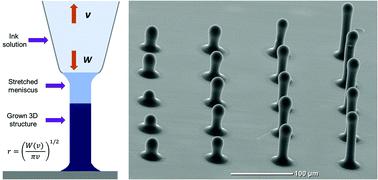当前位置:
X-MOL 学术
›
Polym. Chem.
›
论文详情
Our official English website, www.x-mol.net, welcomes your
feedback! (Note: you will need to create a separate account there.)
Direct writing of 3D conjugated polymer micro/nanostructures for organic electronics and bioelectronics
Polymer Chemistry ( IF 4.1 ) Pub Date : 2020-06-24 , DOI: 10.1039/d0py00719f Seyoung Kee 1, 2, 3, 4, 5 , Peikai Zhang 1, 2, 3, 4, 5 , Jadranka Travas-Sejdic 1, 2, 3, 4, 5
Polymer Chemistry ( IF 4.1 ) Pub Date : 2020-06-24 , DOI: 10.1039/d0py00719f Seyoung Kee 1, 2, 3, 4, 5 , Peikai Zhang 1, 2, 3, 4, 5 , Jadranka Travas-Sejdic 1, 2, 3, 4, 5
Affiliation

|
π-Conjugated polymers (CPs) constitute key elements for the emerging next-generation of bioelectronics, on the basis of their unique optoelectrochemical characteristics, biocompatibility, desired mechanical deformability and printing processability for high-throughput device fabrication. Direct growth of CPs into three-dimensional (3D) structures via solution-based processes has drawn significant attention, as it enables an unprecedented paradigm shift from conventional 2D thin-film-based electronics. Herein, we address 3D direct writing and meniscus-guided pen writing methods, which are capable of fabricating 3D micro/nanostructures from soluble CPs and CP precursors, and recent advances in these techniques. Moreover, we highlight some of the interesting devices developed and their applications that feature unique advantageous properties originating from the fabricated 3D micro/nanostructures of CPs. Finally, we present an outlook on the future direction and possible applications in this field. This perspective review is intended to provide a valuable insight into the emerging field of 3D micro/nanofabrication of CPs and their composites that may inspire the next generation of CP-based (bio)electronics.
中文翻译:

直接写入有机电子和生物电子的3D共轭聚合物微/纳米结构
π共轭聚合物(CP)凭借其独特的光电电化学特性,生物相容性,所需的机械变形能力和高通量器件制造的印刷加工性能,构成了新兴的下一代生物电子学的关键要素。CP的直接生长成三维(3D)结构通过基于解决方案的工艺引起了人们的极大关注,因为它使传统的基于2D薄膜的电子产品实现了前所未有的模式转变。在本文中,我们介绍了3D直接书写和弯月面引导笔书写方法,它们能够从可溶性CP和CP前体制造3D微观/纳米结构,以及这些技术的最新进展。此外,我们重点介绍了一些有趣的设备及其应用,这些设备具有源自CP的3D微米/纳米结构的独特优势。最后,我们对未来的方向以及该领域的可能应用提出了展望。
更新日期:2020-07-21
中文翻译:

直接写入有机电子和生物电子的3D共轭聚合物微/纳米结构
π共轭聚合物(CP)凭借其独特的光电电化学特性,生物相容性,所需的机械变形能力和高通量器件制造的印刷加工性能,构成了新兴的下一代生物电子学的关键要素。CP的直接生长成三维(3D)结构通过基于解决方案的工艺引起了人们的极大关注,因为它使传统的基于2D薄膜的电子产品实现了前所未有的模式转变。在本文中,我们介绍了3D直接书写和弯月面引导笔书写方法,它们能够从可溶性CP和CP前体制造3D微观/纳米结构,以及这些技术的最新进展。此外,我们重点介绍了一些有趣的设备及其应用,这些设备具有源自CP的3D微米/纳米结构的独特优势。最后,我们对未来的方向以及该领域的可能应用提出了展望。










































 京公网安备 11010802027423号
京公网安备 11010802027423号